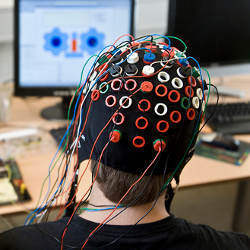In the landscape of technological marvels, few innovations stand as profoundly transformative as Brain-Computer Interfaces (BCIs). These cutting-edge systems bridge the gap between the human mind and external devices, offering new avenues of communication, mobility, and empowerment for individuals facing various disabilities. As we delve into the realms of neural connectivity and technological ingenuity, the story of BCIs unfolds as a narrative of liberation, breaking barriers that once seemed insurmountable.
The Symphony of Neurons and Technology: How BCIs Work
At the heart of BCI technology lies the intricate dance between the human brain and computer systems. BCIs interpret the electrical impulses generated by neurons, translating the language of the mind into actionable commands for external devices. Electroencephalography (EEG) caps or implanted electrodes detect brain signals, opening up a realm of possibilities for individuals who may be paralyzed or have limited motor function.
Breaking the Silence: Communication Beyond Words
For those with severe physical disabilities that limit or eliminate traditional means of communication, BCIs emerge as a beacon of hope. Individuals affected by conditions such as ALS or locked-in syndrome can use BCIs to spell out words, compose sentences, or even engage in real-time conversations, simply by harnessing the power of their thoughts.
Imagine a world where the voiceless find their voice through the silent symphony of their minds. BCIs enable individuals to express their thoughts, emotions, and desires with a level of autonomy that transcends the constraints of their physical conditions.
Beyond Movement: Navigating the World with Neural Precision
Mobility is a fundamental aspect of independence, and BCIs are rewriting the script for those with limited or no control over their bodies. By decoding brain signals, BCIs can be integrated into robotic exoskeletons or prosthetic limbs, allowing users to move and interact with the world around them. For those paralyzed from the neck down, the freedom to move a robotic arm with a mere thought becomes a groundbreaking step towards regaining agency.
The Promise of Neurorehabilitation: Healing Through Connectivity
BCIs extend their reach beyond immediate functionality; they hold promise in the field of neurorehabilitation. For individuals recovering from strokes or traumatic brain injuries, BCIs offer a platform for targeted therapies, stimulating neural pathways and facilitating the rewiring of the brain to restore lost functions.
Challenges and Ethical Considerations: Navigating the Neural Frontier
As we venture into the uncharted territories of the mind, ethical considerations and challenges emerge. Questions about privacy, consent, and the potential misuse of neural data require careful navigation. The responsibility to ensure the ethical development and deployment of BCIs rests on the shoulders of researchers, developers, and society as a whole.
The Future Unfolding: Imagining Tomorrow’s Neural Landscape
The journey of BCIs is far from complete; it’s a dynamic narrative evolving with each technological leap. As researchers explore ways to enhance the precision, speed, and adaptability of BCIs, the possibilities seem boundless. We stand at the threshold of a future where the mind’s potential is harnessed not just for the disabled but for all humanity.
In the tapestry of human achievement, BCIs weave a narrative of liberation, where the mind’s resilience triumphs over physical limitations. As technology continues to push the boundaries of what was once deemed impossible, BCIs emerge not just as devices but as conduits to a world where the power of thought becomes the catalyst for change, one neuron at a time.

































